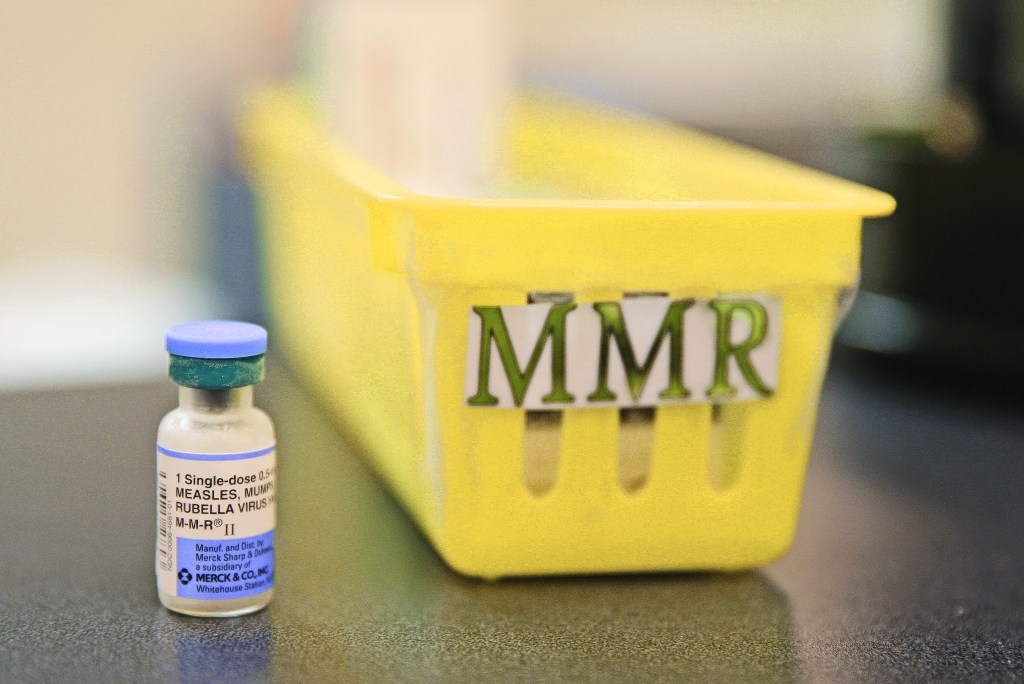Public health mobilized to head off measles outbreak
Published 12:00 am Sunday, March 24, 2019

- A measles, mumps and rubella vaccine at a pediatrics clinic. (AP photo/Eric Risberg, File)
For 10 days in January and February, Deschutes County health officials held their breath and waited for a case of the measles that never came.
A visitor from Clark County, Washington, had potentially exposed hundreds of residents in Central Oregon to the measles, and the health department marshaled its resources to head off an outbreak before it got started.
“It was the classic public-health response: You count cases. You track contacts. You do your best to notify contacts that might be at risk, and to provide opportunities for those exposed and the rest of the population to have an increased level of immunization,” said Dr. George Conway, director of Deschutes County Health Services. “Whether or not that actually prevented secondary cases, we’ll never know.”
County health officials routinely practice for such events. In fact, Morgan Feld, the health department’s emergency preparedness coordinator, had scheduled a dry run for Jan. 30.
Then, two days before the training exercises, the phone rang. Staff at the Juniper Swim & Fitness Center had received a call from a parent whose child had visited the facility Jan. 20 and had developed the symptoms of measles. Shortly after, they received a second call. That person had also visited the Mountain Air trampoline park in Bend.
Typically, that notification is done by one county health department to another.
Once a person tests positive, county officials interview that person to determine where he or she may have been during the infectious period, and then notify other health departments of the potential exposures in their counties.
“This wasn’t a confirmed case,” said Heather Kaisner, program manager for Deschutes County Public Health. “The person whose child was suspected at the time end up being the ones that called those facilities.”
Taking action
Kaisner says the health department takes all reports of measles seriously, but staff had to confirm this was more than a rumor. They contacted the Oregon Health Authority and began to investigate the case.
Measles can have an incubation period of up to three weeks after exposure, and those infected are generally infectious four days before their first symptoms and well before they realize they are sick. Symptoms start with a fever and runny nose and progress to the telltale rash. Blood tests are needed to confirm measles, and testing is more accurate once the rash develops.
Deschutes County was able to learn the person in question had developed those symptoms and was awaiting a blood test. They also confirmed the person had been at a confirmed measles exposure sight in Clark County.
With rumors of a measles outbreak swirling in Central Oregon, the health department opted to put out a release that day to give local residents information about how to protect themselves.
“We went into action,” Kaisner said. “That same day we started working with the facilities to determine who was there.”
The health department activated its incident command system, a federal model for public agencies to respond to any sort of incident or event. The structure has one person in charge with other team members divided among planning, operations, logistics and finance teams. The model can be easily scaled up or down as needed.
The health department has used that model to manage its response to the Ebola outbreak in 2014 in anticipation of U.S. cases, to the H1N1 pandemic in 2009 and, in conjunction with other county officials, for the solar eclipse in 2017.
Kaisner took the lead as the incident commander. The team met every morning to plan out the day and late in the afternoon to debrief.
“Our biggest priority was getting in touch with people who had been exposed and let them know about the exposure,” said Kathy Christensen, communicable disease supervisor and operations chief for the measles response.
Fortunately, both facilities had good records of who was there on those days. Mountain Air requires patrons to sign a waiver and was able to provide a list of names and contact information. Juniper was able to check what members had checked in that day, but had no records of who visited their facility on day passes.
About 1,500 people had visited the two facilities, and the health department pulled in all of its staff to help contact them and check their immunization status.
Within the first week of exposure, one team called or emailed 486 Deschutes County residents and reviewed the immunization records of 388 people determined to be most at risk. The health department can check ALERT, a state database of vaccinations, but those records mainly include those immunizations given in Oregon. Some doctors take the time to enter in past vaccinations when they have patients who came from other states.
“For kids, the records were pretty complete,” Christensen said. “Adult records were not as complete.”
Another team manned the phone, fielding 108 calls from concerned residents asking about their risk, and another 72 calls from health providers wanting additional information.
They worked through their list of possible exposures in the first couple of days of their investigation, sorting through who had been where, and who had received what shots. They identified 16 children who were unvaccinated and at one of the exposure sites, who needed active monitoring.
“We have a nurse that calls or gets a hold of that person every day and asks them if they’re having any symptoms so we could nip it in the bud very quickly so they don’t expose other people,” Kaisner said.
Starting the clock
By Jan. 30, tests had confirmed the Clark County visitor did indeed have the measles. From the day of the last exposure, Jan. 20, the staff counted forward 21 days, setting Feb. 10 as the end of the incubation period. If there were no cases of measles by the end of the three weeks, the region’s risk of a measles outbreak would drop to baseline levels.
They were at the halfway mark. The health department urged all 16 unvaccinated individuals to stay at home as much as possible, particularly if they experienced any symptoms.
“Everybody who was in active monitoring was very understanding and compliant,” Kaisner said. “It was voluntary, but they understood the importance.”
The health department used the incident command structure to play out various scenarios: what would happen if they had a confirmed measles case. They worked with local doctors and other health providers to be prepared for potential cases, to ensure they had a way of bringing in suspected cases for evaluation without exposing the entire waiting room to one of the most contagious known viruses.
Clinics identified side entrances and dedicated exam rooms for potential measles patients. The health department urged the public not to just show up at a doctor’s office or emergency room, but to call ahead and make arrangements.
The health department reached out to schools and day cares to be prepared to send home any kids who weren’t vaccinated if a school was identified as an exposure site. Out of 18 elementary schools in the Bend-La Pine district, only six were above the 95 percent vaccination threshold needed to provide herd immunity. Another three charter schools in Bend and four schools in Redmond and Sisters were also below the threshold. In Deschutes County, 5.5 percent of students from kindergarten through 12th grade — some 1,500 students — have a nonmedical exemption for the measles.
“We were prepared for that,” Kaisner said. “But luckily we didn’t need to.”
The staff was prepared so if someone came down with the measles, the staff would determine the period during which he or she was contagious and track that person’s movements to identify potential exposure sites. That would start a new incubation period clock and create a new list of people to contact and check for symptoms and immunization status.
“Hopefully if they were under active monitoring and they told us their symptoms right off the bat and they were isolated, then no one was exposed,” Kaisner said.
Working overtime
The first week after the exposure was the busiest. The core team of seven communicable disease specialists at the health department worked a combined 330 hours in six days. The potential exposure created a large demand for the measles, mumps and rubella vaccine, both from pediatric clinics and at the health department. Most were children whose parents had put off vaccination for one reason or another, and the potential of a local outbreak prompted them to come in.
After the initial week, it became clear the chances of a large outbreak were waning. They pulled back from their daily meetings and thrice weekly conference calls with the Oregon and Washington state health officials.
But over those crucial 10 days, there was nary a fever or a runny nose to speak of. The incubation period ran out without a suspected case, and the health department breathed a collective sigh of relief.
They resisted the urge to celebrate, to hold a party for a job well done and crisis averted.
“We didn’t want to jinx it,” Kaisner said.
The health department has estimated the cost of the measles investigation at $20,000, money that had to be pulled from other parts of the agency’s budget. It was a costly exercise that will leave the county better prepared for the next infectious disease concern.
In truth, Central Oregon could see a measles outbreak at any time. And with an ongoing outbreak just a three-hour drive away, the health department can’t afford to be complacent: With spring break travel starting this weekend, the county could be right back in the same situation in a heartbeat.
And the countdown would begin again.
— Reporter: 541-633-2162, mhawryluk@bendbulletin.com





